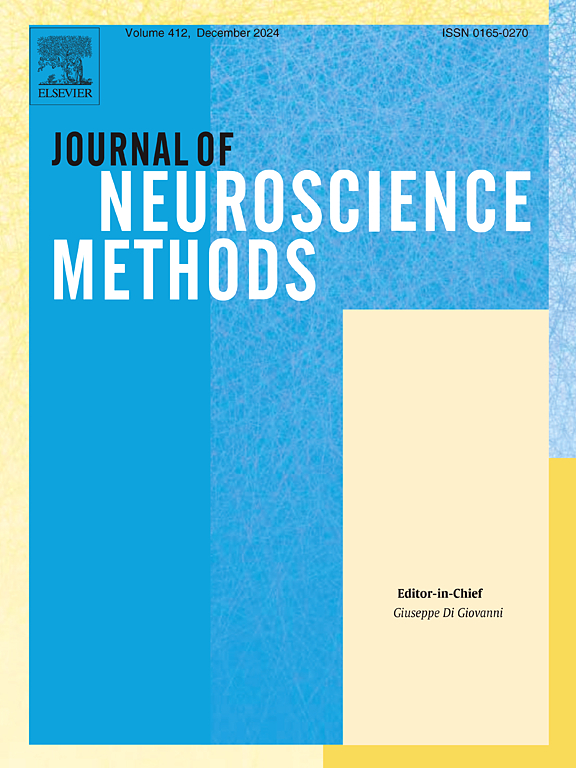脑片突触连接的光遗传估算。
IF 2.7
4区 医学
Q2 BIOCHEMICAL RESEARCH METHODS
引用次数: 0
摘要
背景:检测突触连接对于了解神经回路至关重要。通过使用光遗传学、电流注入和谷氨酸释放来激活突触前细胞,并同时记录突触后细胞的后续反应,可以确认突触连接的存在。然而,这些方法都面临着通量方面的挑战,例如需要同时进行多细胞膜片钳记录和双光子显微镜检查。这些挑战导致了牺牲分辨率和实验通量之间的权衡:新方法:我们采用了通常用于局部场消融的激光,并将其与事后分析相结合。新方法:我们采用了通常用于局部场消融的激光,并将其与事后分析相结合。我们仅使用了外显荧光显微镜和单细胞记录,就成功逼近了突触连接概率:结果:我们依次刺激了记录细胞周围的通道荧光素 2 表达细胞,并估算出了突触连接概率。该概率值与同时进行多细胞贴片钳记录(包括 600 多对细胞)获得的概率值相当:与现有方法的比较:我们的设置使我们能在 100 秒内估算出连接概率,优于现有方法。我们仅使用外显荧光显微镜和单细胞记录通常使用的光路,就成功估算出了突触连接概率。该方法也适用于树突消融实验:结论:所提出的方法简化了连接概率的估算,有望推动对自闭症和精神分裂症等神经回路的研究。此外,这种方法不仅适用于局部回路,也适用于长程连接,从而提高了实验吞吐量。本文章由计算机程序翻译,如有差异,请以英文原文为准。
Optogenetic estimation of synaptic connections in brain slices
Background
Detection of synaptic connections is essential for understanding neural circuits. By using optogenetics, current injection, and glutamate uncaging to activate presynaptic cells and simultaneously recording the subsequent response of postsynaptic cells, the presence of synaptic connections can be confirmed. However, these methods present throughput challenges, such as the need for simultaneous multicellular patch-clamp recording and two-photon microscopy. These challenges lead to a trade-off between sacrificing resolution and experimental throughput.
New method
We adopted the laser, typically used for local field ablation, and combined this with post hoc analysis. We successfully approximated the synaptic connection probabilities using only an epi-fluorescence microscope and single-cell recordings.
Results
We sequentially stimulated the channelrhodopsin 2-expressing cells surrounding the recorded cell and approximated the synaptic connection probabilities. This probability value was comparable to that obtained from simultaneous multi-cell patch-clamp recordings, which included more than 600 pairs.
Comparison with existing methods
Our setup allows us to estimate connection probabilities within 100 s, outperforming existing methods. We successfully estimated synaptic connection probabilities using only the optical path typically used by an epi-fluorescence microscope and single-cell recordings. It may also be suitable for dendritic ablation experiments.
Conclusions
The proposed method simplifies the estimation of connection probabilities, which is expected to advance the study of neural circuits in conditions such as autism and schizophrenia where connection probabilities vary. Furthermore, this approach is applicable not only to local circuits but also to long-range connections, thus increasing experimental throughput.
求助全文
通过发布文献求助,成功后即可免费获取论文全文。
去求助
来源期刊

Journal of Neuroscience Methods
医学-神经科学
CiteScore
7.10
自引率
3.30%
发文量
226
审稿时长
52 days
期刊介绍:
The Journal of Neuroscience Methods publishes papers that describe new methods that are specifically for neuroscience research conducted in invertebrates, vertebrates or in man. Major methodological improvements or important refinements of established neuroscience methods are also considered for publication. The Journal''s Scope includes all aspects of contemporary neuroscience research, including anatomical, behavioural, biochemical, cellular, computational, molecular, invasive and non-invasive imaging, optogenetic, and physiological research investigations.
 求助内容:
求助内容: 应助结果提醒方式:
应助结果提醒方式:


